Welcome to a new issue of the Journal of Runic Studies, the premier Malkioni publication for studies into the nature of Glorantha. If you haven’t subscribed yet, please consult with the spirit bound to the appropriate electronic page.
This week has been dominated by the OGL-apocalypse and the massive amounts of people asking for game recommendations beyond D&D and 5e games. Of course, all the BRP fans came out of the woods and supported their favourite Chaosium games including RuneQuest. My social media and RSS filters were absolutely filled with all these replies, which is cool, but also possibly drowned any cool Glorantha-related stuff that happened this week. So if I missed something cool, ping me!
Chaosium News

Here are this week’s Chaosium news!
Truly Epic Campaigns
Jeff talks to James about running multi-year campaigns of RuneQuest. Topics include the “Taming of DragonPass” campaign which used the “PenDragon Pass” rules hack (more here and here about this), the scalability of BRP-based systems, going beyond published material, and lots of other advice!
New Gamemaster Month is Back

The first step is to get a copy of the Starter Set, and then you just sit back and skim through it while waiting for the step-by-step instructions that will be published every week until the end of January. That will be easier than Befuddling a trollkin!
Jonstown Compendium

The Jonstown Compendium is Chaosium’s community content program for all Gloranthan games, hosted on DriveThruRPG. Disclaimer: all the relevant links are affiliate links that hopefully will let us cover some of the hosting and maintenance costs for the website and podcast! Thanks for using them!
Crimson King
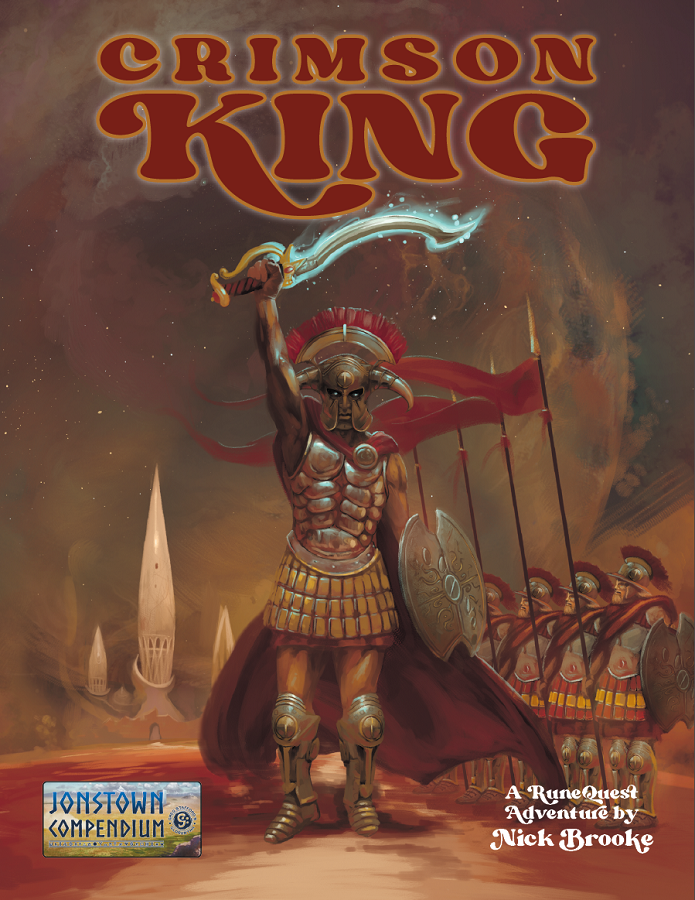
Nick Brooke’s latest Lunar extravaganza is out! Yay!
A game of intrigue and conspiracy in the highest echelons of the Lunar Empire! Players take on the roles of the heroes and rulers of this Gloranthan superpower, confronted by treachery and betrayal on all sides.
For the occasion, both volumes of Life of Monsoon (The Characters and The Freeform) are on sale with a discount, so you can grab all of that in one fell swoop.
In Search of Baroshi
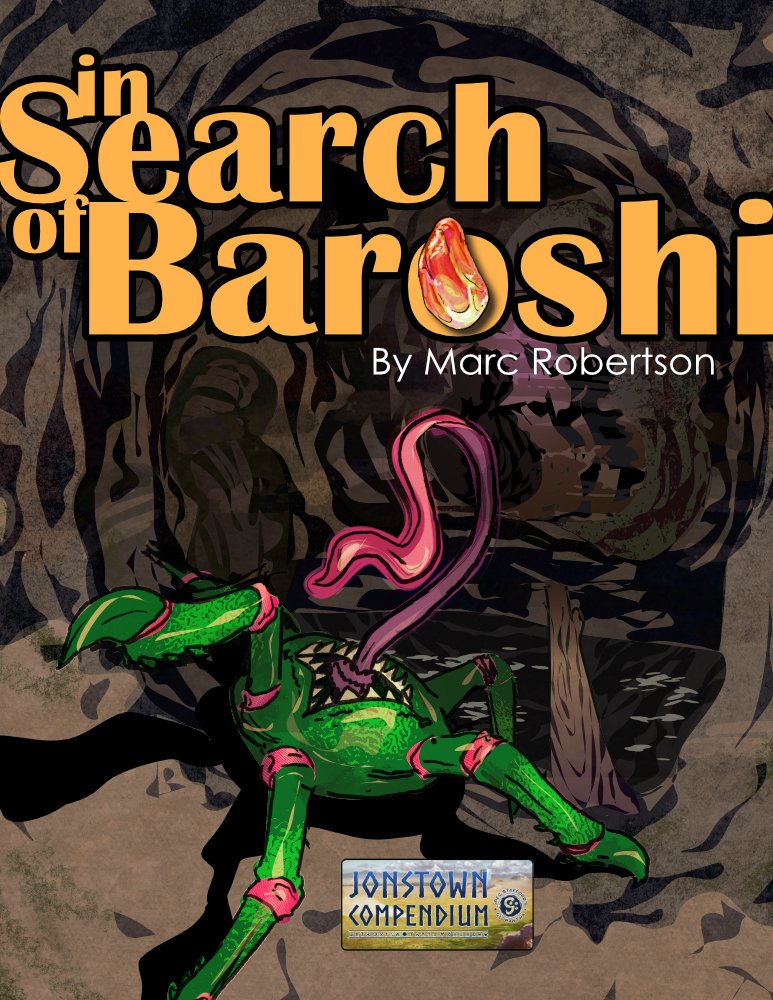
Help a spirit by rescuing the ancient godling Baroshi in this adventure for RuneQuest suitable for a couple of sessions. The pack also includes some VTT resources.
Zenith Counters Adventure Pack #4: Balastor’s Barracks
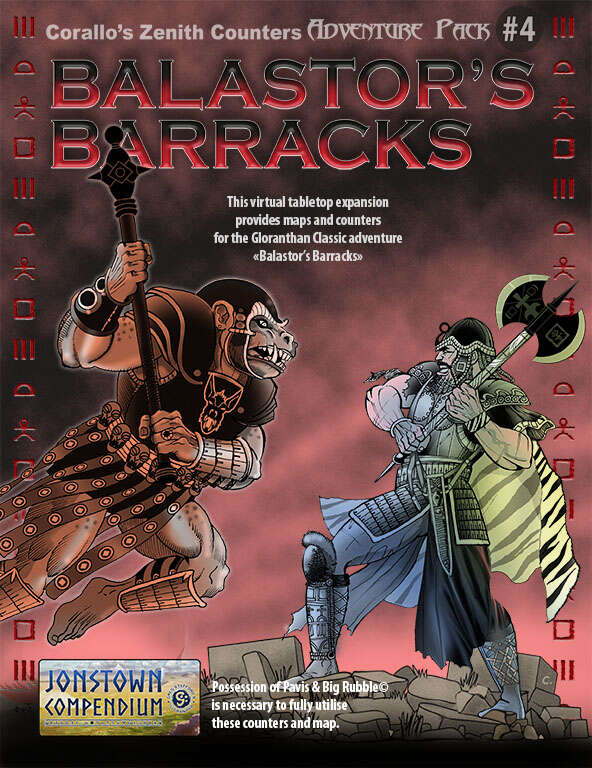
Play some old school adventure in a new school style! The classic RQ2 Big Rubble dungeon crawl “Balastor’s Barracks” (available here in PDF/POD) now has some VTT maps and tokens, courtesy of Dario Corallo.
Zenith Counters Troll Bundle
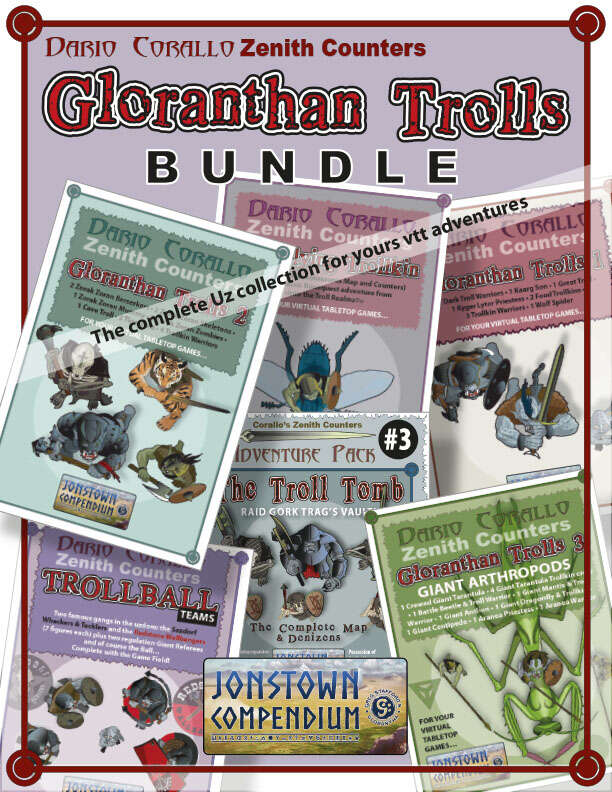
Dario Corallo also has a bundle for all his troll-related Zenith Counters. If you plan on meeting trolls in a VTT, Dario’s got you covered.
Jeff’s Notes

Jeff Richard, the current mastermind on everything Gloranthan at Chaosium, is often posting notes and thoughts on the RuneQuest Facebook group. Here’s our curated list from the past week. A partial archive of these sources is compiled on the Well of Daliath.
Top of the World
The “Top of the World” is another Gloranthan landmark that has completely escaped me until now:
In Dragon Pass, Kero Fin is the mother of Orlanth, but for much of Peloria, Fronela, and Ralios, Orlanth resides atop Top of the World. This high peak is some 10,000 meters high, and is the Gloranthan Mount Everest.
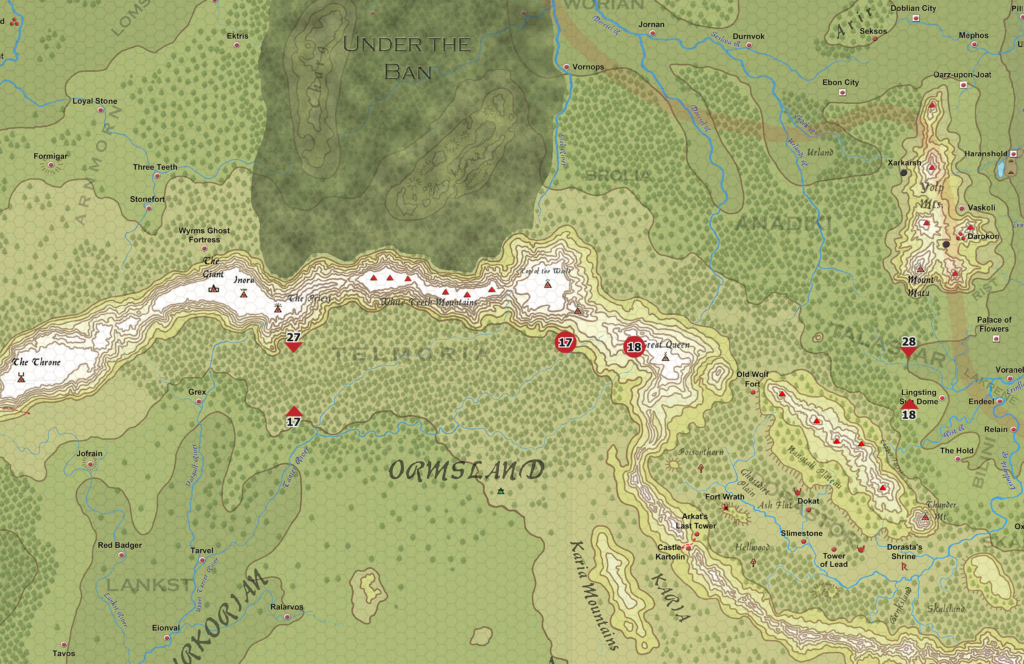
This mountain is that big white blob in the centre of the above map. It’s located at the intersection of Ralios in the south (and specifically Telmoria, for some added fun), Fronela in the north, and the western Lunar provinces in the east. It’s listed under the write-up for Talastar in the Guide. Talastar in general is a rocky and hilly area of sheep herding Orlanthi. Brolia, the closest region to Top of the World, is even rockier and harsher, to the point that the tribes there don’t even farm.
All these Orlanthi tribes technically live under the rule of the Lunar Empire, but neither party seems to be very into it. The Lunars just wanted to mark this area on the map as “living under the Lunar Way”, and the local Orlanthi just wanted to do whatever was easiest to get the Lunar missionaries to go the fuck away. Everybody smiled, the Lunar distributed some white robes to the tribal representatives, the tribal representatives replied with some bullshit, and all went home. This was in 1590, and is remembered (and I kid you not) as “White Shirt Day” to the locals.
Top of the World is sacred to the Orlanthi of Peloria, Fronela, and Ralios, and has many temples and shrines on its slopes. Great Orlanthi magicians are known to fly over the Rockwoods between Top of the World and its mate, the Great Queen.
A fun fact is that, again according to the guide, these holy places let you “get in touch” with the Storm God freely. From far away it might only happen on High Holy Days, but as you get closer, you can contact Orlanth on any Windsday. In terms of RuneQuest mechanics I figure that maybe you can do some worship without Sanctifying the ground, and maybe you get discount on some Divination or something.
Top of the World is often associated with the Spike, and among Orlanth’s titles here are “Son of the Spike” and “Breath of the Spike”. From atop this peak, Orlanth centered himself, gathered his vital air but did not release it, building up tremendous energy. When he is ready, Great Orlanth discharges his breath as a terrible bolt. Dedicated Orlanthi can learn his magic at his temple at Tarvathlinpor (“Place of the High Breath) at the shoulder of Top of the World.

Now for many lowland Pelorians, Top of the World – easily seen in Doblian, Sylila, and the West Reaches – is a home of violent and dangerous storm demons. The locals there are backwards bandits, who herd sheep in great poverty. But they are known for having powerful magicians who live on the slopes of the peak.
Religion in Safelster
Safelster is one of those super cool regions of Glorantha that would benefit from having a campaign set there… well, frankly, most regions of Glorantha are super cool and would benefit from having a campaign set there but I digress. Safelster is the area in southern Ralios centered around Lake Felster.

It’s highly populated, has fertile lands, is dotted with city states engaged in various political schemes against each other, and has a whole bunch of diverse wizards and priests from all manners of philosophies and cults:
About 10% of the population still follows the “Old Gods“. This is a hodge-podge of shamanic cults, spirit worship, ancestor worship, and the like. These cults have had syncretism with the Theyalan and Malkioni religions and barely resemble their original forms.
Fun fact: the term “Theyalan” is mentioned repeatedly in the RuneQuest rulebook (almost always in the context of languages and writing), but never defined. This is the kind of editorial problem that makes it difficult to get into Glorantha, and something that was raised by Baz a few times in his excellent RuneQuest Year Zero short podcast series about discovering the RuneQuest Starter Set.
Anyway, you can almost always substitute “Theyalan” with “Orlanthi”. The term was originally coined by the God Learners to talk about the people who, shortly after the Dawn, spread the worship of the Lightbringers.
About 27% follow the Lightbringers and Earth religions of the Theyalans. These have also incorporated local deities and spirits, and have added many heroes, most recently Siglolf Cloud-Crusher, a subcult of Orlanth Thunderous.
Siglolf Cloud-Crusher comes from Lankst, a fertile and well populated Orlanthi kingdom located north of Lake Felster (a bit outside the map featured above). Garundyer of the Seven Storms, a contemporary Lankstite Orlanthi hero, is responsible for “bringing back” Siglolf with his heroquesting — in fact, Garundyer is described in the guide as “currently the most powerful Orlanthi Heroquester in Glorantha” (for a “current” based a few years before RuneQuest Glorantha’s 1625).
Siglolf gives you the magic to hurl rocks down from rain clouds. Garundyer has a whole bunch of other cool, powerful, and sometimes a bit silly battle magic, too — you can find all about it in the Guide.
About 20% follow Rokari Malkionism. The zzaburi look to Leplain for support and guidance.
Leplain is a large city west of Lake Felster (look just below that large marsh area on the map above). It’s technically in Seshnela, so if you’re following at home, you need to switch over to volume 2 of the Guide to find it. The city is nicknamed “The City of Wizards” and that’s where the Watcher Supreme, chief sorcerer of the Rokari, and most of the main Rokari schools and libraries are.
About 5% follow other “orthodox” Malkioni sects such as the Boristi, Galvosti, and Old Hrestoli.
These orthodox sects are variants of Malkioni religion that date back a long time and differ from other Malkioni philosophies in small ways:
- The Boristi were founded during the Gbaji Wars, so they are all about freely Tapping Chaotic creatures (the Tap technique being the rough collection of sorcery spells that leech/absorb/steal something from something else… see the RuneQuest rulebook). In contrast, most Malkioni think that Tapping is bad and either avoid it or flat out ban it. The RuneQuest rulebook chapter on sorcery sadly doesn’t mention this at all, so careful about ending up with a Lhankor Mhy adventurer who upsets western sorcerers.
- While the Boristi’s Tapping comes from good intentions (you know, the thing that paves the road to hell… open the Guide and look up why the Boristi are called “squids”), the Gavosti are a bunch of assholes: they happily Tap any non-Malkioni people. They almost got wiped out by understandably-upset barbarians at the end of the Second Age, but they still persist.
- I’m not sure what “Old Hrestoli” are. Generally speaking, as I understand it, the Hrestoli are those who believe in mobility between the traditional Malkioni castes (worker, soldier, noble, wizard), with a select elite going through all castes to become “Men of All” (a sort of “knight” status). I suppose that the Old Hrestoli stick to the old version of that, without any of the new age progressive views of the New Hrestolism? I don’t know…
About 33% follow what is commonly called one of the Stygian Heresies. This includes the Chariot of Lightning sect, which some 8% of the total population follows.
We already looked a bit at the Stygian Heresies here and more specifically here, but Jeff gives some welcome description too:
The Stygian Heresies are esoteric syncretic cults that claim origin in the early Second Age, and incorporate elements of Malkionism, Lightbringers, and Troll religion. They have distinct and secretive theologies. First and foremost they all claim to be the inheritors of esoteric knowledge derived from the personal spiritual experience of Arkat, that is above any orthodox teaching, tradition, or authority derived from Malkion.
Secondly, they all identify Gbaji the Deceiver as the great moral evil of the world. Arkat’s struggle with Gbaji is the source of his spiritual authority (which all agree is of a superior authority to Malkion or others).
Beyond that, the sects are all over the map. Some sects openly display themselves. However, most hide and pretend to be orthodox Malkioni (especially Rokari) or are initiates of other local cults. As one hidden Archon is cited – “if any religion is stronger than you, follow it, but keep the secret truth in your hearts.” Many sects permit or even demand that members deny their membership to outsiders – such dissimulation was required for the survival of the sect during periods of persecution and have been maintained. Their beliefs are concealed from outsiders, and members are encouraged to be lay members of other cults Many sects forbid marriage outside the sect.
The Chariot of Lightning sect was mentioned earlier so it’s worth looking at it too. It is a fast growing cult located mostly around Oktorion, the area north-northwest of Lake Felster around the Upper Tannier River (see the map above). That’s also where the aforementioned Siglolf cult is very popular. It believes that “Orlanth is the Supreme Deity, the creator, preserver, destroyer, revealer, and concealer of all that is, and that other deities are important also and deserve worship for their aid and protection.” It sounds like some weird-ass Orlanthi sorcerers thing?
As you might imagine, it’s not very popular among the Malkioni who think that the Invisible God is the Supreme Deity, and that the gods and spirits of other religions are not worthy or worship — only worthy of being used for magic points. But hey, the Chariot of Lightning has the support of Lankst and Garundyer, which means that, so far, anybody who didn’t agree has been utterly crushed by armies powered by crazy storm magic. Better get on their good side…
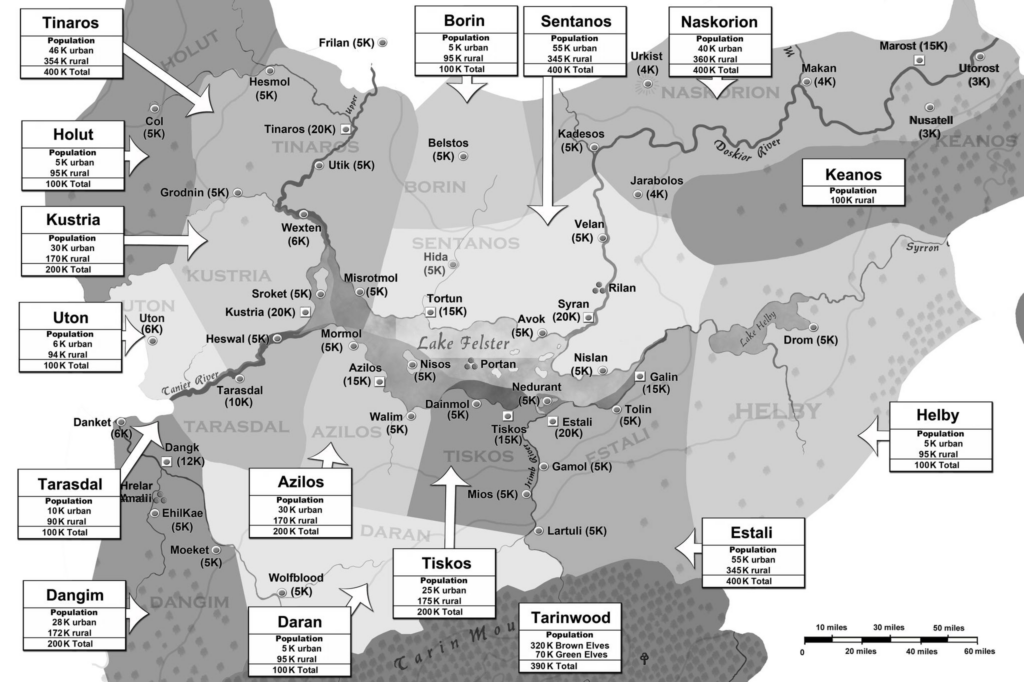
Anyway, these annotation have gone long enough. Jeff has a few more thoughts on Safelster worth reading, and a short extra bit on playing Hrestoli and Zzaburi adventurers.
Malkioni Heresies
More on the Stygian Heresies and other distorted forms of Malkionism:
Most Malkioni are far more concerned about heretical sects of Malkionism than about non-Malkioni subjects. Arkatism or “the Stygian Heresy” is considered one of the most heretical outgrowths of Malkionism.
So for example, when the Seshnegi conquered Safelster, the Orlanthi, Aldyrami, followers of the Old Gods, etc., were likely left alone. Orlanthi warriors could become horali or dronari and keep their cults, Issaries cultists could even claim descent from Talar and become low-ranking talars. These people had to declare loyalty to the King (later Emperor), temples had to pay a special tax, and so on, but were basically allowed to practice their traditional rites unmolested.
Even though the plebe worship their gods (usually Orlanthi), I imagine that once they’ve been conquered they are at least forced to become lay members of the Invisible God or something. The Malkioni wizards do need lots of magic points after all.
The conquest of Sefelster (and Ralios in general) by the Seshnegi sort of happened twice. Once was in the mid 700s when the God Learners broke up Ralios and stole the Arkati secrets… you might say that’s arguably more of a Jrusteli invasion than a Seshnegi one, but the God Learners technically came from Seshnela originally, and reconquered it before conquering Ralios, soooo… plus, they put Seshnegi titles on the new Ralios Overlords. Anyway, that went sideways when the God Learners were destroyed, but the Seshnegi came back in force in the mid 1400s when King Ulianus III (re)conquered half of Ralios.
The same tolerance did not apply to wayward Malkioni – especially wayward zzaburi. Arkatism was viewed as a heresy, and followers were accused of consorting with Darkness demons and worse.
[…]
Of course, in the Third Age Malkionism has largely been in retreat, and few Malkioni in Genertela have many non-Malkioni subjects.
That being said, Malkioni rulers are known to destroy temples that are perceived as being overly powerful, rebellious, or threats to them.
More here.
Ralios Orlanthi
More on Ralios! Remember that the aforementioned Top of the World, arguably the most sacred Orlanthi mountain, is nearby… so:
The Holy Country has about 357k Orlanth initiates (and I mean initiate of Orlanth, not Orlanthi culture). Peloria has 225k and Dragon Pass has just under 100k.
But Ralios has some 560k Orlanth initiates!
In Ralios, the cult is centered on Top of the World, and was likely the God Learners primary source of information about Orlanth in the Monomyth.
Historically the Orlanthi of Ralios supported Arkat against Gbaji, and opposed the EWF in the Second Age, with Alokaring Dragonbreaker hailing from the region (he’s famous not only for kicking the EWF’s ass, but also for founding the Orlanth Rex cult, which defines Orlanthi culture, law, and politics in Dragon Pass, among other places.
There are werewolves, barbarian dragonewts, elves, dwarves, and trolls a plenty in Orlanthi Ralios, as well as a growing danger from Dorastor. But the Orlanth cult here is not defined by conflict about the Lunar Empire – the Red Goddess is an evil from beyond the Rockwoods, but is an abstract evil. Ballid, Nida, Guhan, and Argin Terror are more obvious threats is Vesmonstran, and Halikiv and Dorastor are more obvious threats in East Ralios.
Vesmonstran is the broader region of the Upper Tanier River in northern Ralios. It’s composed of Oktorion and Lankst (that should ring a bell), which you can spot respectively in the previous Safelster map and the further up above Top of the World map.
Let’s look up what those threats are:
- Ballid is the big Aldryami forest west of Lankst. It used to be super super big at the Dawn (back when elf forests covered a large portion of Genertela), but now it’s only a small fraction of what it was… even if there are more than 300,000 elves in there. Of course, they’re working on great reforestation projects, which are generally bad news for non-elves.
- The Nidan Mountains are super important to dwarfs — that’s from where the Decamony rules over all Mostali of the continent, and where dwarfs build muskets and pistols. They also control High Llama Pass, the best way to cross the mountains between Fronela and Ralios. Count another 300,000 dwarfs here. I’m not convinced that they are an active threat (I don’t see any particular reason for them to bother the Ralios Orlanthi), but who knows what sort of devious World Machine plans they have in motion.
- Guhan is a whole different bag of trouble. Look for it at the top left the above Safelster map, around the three peaks of the Uzgor Mountains. Not only is it a stronghold of the trolls, it’s a stronghold of Arkati trolls (Arkat told them to come here). That’s “Mr. bad ass wizard trolls” for you. If you’ve heard of “The Swarm” (a big caravan of trolls and giant arthropods that crossed Dragon Pass in 1623 on their way to Dagori Inkarth), well, it came from here. Guhan has about 250,000 trolls (most of which would be trollkin of course). Expect regular troll raids, because these trolls don’t give a fuck.
- Halikiv is another troll stronghold. It has a Castle of Lead (where Kyger Litor resides) just like in Dagori Inkarth, and they have a big population of Zorak Zorani berserkers. However, it’s smaller than Guhan (120,000 trolls).
- Dorastor is of course the Chaos winter wonderland that’s on the other side of the mountains to the east. Don’t go there. Just don’t.
So if you want to set your RQ campaign in an Orlanthi land, without a Lunar Empire, without Prince Argrath and his Sartar Magical Union, look at places like Lankst or the East Wilds. You can have trolls, dwarves, elves, dragonewts, and the like, without that story going on.
You can introduce the Chariot of Lightning sect as a new charismatic sect that gives sorcery to Orlanthi. Maybe it has the feel of Thulsa Doom/Jim Jones, or maybe it is like the prophet Mani or the Maharishi Mahesh Yogi (guru to the Beatles and the Beach Boys).
To help you choose, Jeff splits the Orlanthi of Ralios in three groups: the hillbillies of the East Wilds who are nonetheless most similar to the Orlanthi of Dragon Pass, the religious-military alliance of Vesmonstran if you want less sheep herding and more battles, and the savvy, diverse, and Malkioni-tinted Orlanthi of Safelster. More here.
Storm Pantheon Genealogy
Here’s another mythology sneak peek! Nothing new or surprising, just cool stuff.
Orlanth is the grandson of Earth and Sky, his siblings are the winds, a bull, a cat, violence, evil, the mountain snow, and Death. He married the Green Lady, and his offspring include the Plow Man, Spring, the sheep god, a bear god, and a king. Orlanth turned himself into a woman to fight a foe no man could kill, slew a devouring dragon to bring forth rain, and killed his cousin Sun as a final in a series of contests.
Now that’s some proper mythology!

Issaries and Etyries in Central Genertela
Jeff talks about the differences and commonalities between the Issaries and Etyries cults. If you only have the RuneQuest rulebook, you know Etyries as one of the Seven Mothers… she’s the Lunar merchant deity, and often considered a daughter of Issaries.
Nothing very surprising in this note (both cults collaborate for trade’s sake, but are also competitors, so overall neutral to each other, and neutral in general), but I found this bit interesting:
Etyries has the special Rune spells of Exchange Spells, Path Watch, and Reflection. She cannot create Neutral Ground like Issaries.
Etyries is the Lunar goddess of traders, not of marketplaces or neutral grounds for trade. Her cultists are not neutral—they are agents of the Lunar Empire, buying and selling goods on behalf of their rulers, nobles, financiers, or temples.
This means that there’s still value in having Issaries priests around, even in the Lunar Empire, in order to create neutral grounds through magic. Furthermore:
It is not out of the ordinary for an Issaries caravan to hire on an Etyries initiate when traveling through the Lunar Provinces, just as any sensible Etyries caravan hires on an Issaries initiate when traveling through Sartar or the Holy Country.
Another interesting bit is how Issaries (and his initiates) is only neutral until he gets a formal Lightbringers Summons:
I actually think this is part of the Lightbringers power. They are not kin or a tribe. They are not a warlord and his companions. They are a group of powers that are united to end the Greater Darkness and restore the world. Of them, only Orlanth is an elemental deity. We get Truth and Stasis, Illusion and Disorder, Life, Harmony and Motion, the Man Rune, and Magic and Spirit. The only thing we are missing is Death – but that is perhaps hidden in Air, and is Orlanth’s great threat. But as they seek to restore the world, perhaps Death must be sheathed.
If we check these Runic associations of the Lightbringers, we get Orlanth (Air), Lhankor Mhy (Truth and Stasis), Eurmal (Illusion and Disorder), Chalana Arroy (Life and Harmony), Issaries (Movement), Flesh Man (Man), and Ginna Jar (which leaves us Magic and Spirit). Interestingly enough, we actually get Movement three times (which we could characterize as Orlanth’s recklessness, Eurmal’s adaptability, and Issaries’ path finding), and Harmony twice (let’s say: Issaries’ bargaining and Chalana Arroy’s peace-seeking). That’s maybe appropriate for a group of people who need to travel far and fast to make peace with the Sun and repair the cosmos…
Read more if you want to know how Argan Argar and Lorkanos fit in these arrangements.
Lhankor Mhy in Central Genertela
The cult of Lhankor Mhy is split in two:
There are roughly 100,000 initiates of the Knowing God in Central Genertela. This includes those that call the god Lhankor Mhy (probably about 60%), and those that call him Buserian (maybe 40%). That’s a linguistic-organizational distinction, and not two separate gods.
Buserian is the Dara Happan god of writers, scribes, and astrologers for the Sun pantheon… but both cults are aware that they effectively worship the same deity. They have different centres of interest (the Dara Happans are a lot more interested in celestial movements), but also overlapping or complementing ones. This means that, just as the ancient Greek philosophers sometimes travelled far and wide to check out some landmark, consult some foreign library, or meet some esteemed writer, so do the Gloranthan philosophers:
So remember, your sage character is part of a much wider world of scholars and literacy. You might be advising some tribal ring in the hill country of Sartar, but you were trained by a master in Boldhome or Jonstown who corresponded with scribes in Nochet, Furthest, and beyond. Perhaps you entertained yourself with a translation of the Fortunate Succession or Hepherones?
There’s a lot more advice and examples in the original note, so check it out.
Note that, of course, the Lunar Empire has the Irripi Ontor cult, but that’s a different deity.
Chalana Arroy in Central Genertela
Similar to the previous note, but with Chalana Arroy:
If we look at Chalana Arroy in Central Genertela, we find that it is actually a surprisingly big cult – some 140,000 members in total. The cult is most densely numbered in Esrolia, but the Lunar Heartlands is the other major center for the Goddess of Mercy.
Pretty much everybody likes Chalana Arroy except creatures of Chaos.
Chalana Arroy is strictly neutral, showing favoritism for none. She and her followers are pacifists, vegetarians, and studiously non-political. […]
If [Chalana Arroy healers] start showing favoritism, you do run the risk of your Goddess sending out the spirit of reprisal.
I think that’s very tricky to quantify. Working on a purely first-come-first-serve basis is not scalable at all given the magic point economy and the practicalities of running a hospital with a finite number of beds. So of course while Chalana Arroy healers strive towards no favouritism, there’s a lot of blurred lines to walk around. And they’re only human, with all their flaws and biases. In my opinion, this is the kind of shit that gives you the Zero’th Law of Robotics or the madness of Sharon Apple. That’s sort of the themes I played around in one of my short stories here. Illumination gets you around spirits of reprisal anyway, and it’s not that uncommon if you play in the Lunar Empire.
This interesting interplay between Chalana Arroy and Lhankor Mhy is a good source of ideas for adventures or for justifying the presence of a PC:
Her temples are another important source of literacy, and no doubt there are many books and texts on herbs, medicine, anatomy, etc. Her temples form a network of hospitals and healers, charities caring for the sick, wounded, and destitute. […]
If we look at the interplay between Chalana Arroy and Lhankor Mhy, we see that the initiates of Chalana Arroy are taught writing and alchemy in the temples of the Knowing God.
And here’s an interesting note about playing a Chalana Arroy initiate — I hadn’t thought of Prince Ezran in that light:
CA often gets played as an often-frustrated healer in a party of warriors. My suggestion is to turn that around. She’s a radical alternative voice, seeking healing rather than combat. Heal the foe, offer them mercy, and throw yourself on their mercy rather than resort to violence.
A nice example of this is Prince/King Ezran from the Netflix series The Dragon Prince (which I watched with my kids).
I also watched The Dragon Prince with my kids and it was great! You can even get the roleplaying game now (powered by Cortex Prime). The book looks great, but it sadly looks a bit too crunchy for kids and newbies… I haven’t actually tried playing it yet though, so maybe that’s a false first impression (comments welcome if you’ve played it!)
Zzaburi in Western Genertela
And one last bunch of people who interact with the Lhankor Mhy sages: the sorcerers in the west:
There are somewhere around 120,000 zzaburi in Seshnela and Ralios. Now of them, about 79,000 adhere to the Rokari school.
[…]
Now many of these zzaburi are in contact with their Knowing God counterparts, at least in Safelster. However, their scripts is Western, a very different script from Theyalan. Nonetheless, I suspect that in Safelster we have transmission of lore between the Theyalans and the Malkioni, back and forth. Sometimes these two groups get along, sometimes I suspect they have violent riots against each other.
Remember there are some 45,000 initiates of Lhankor Mhy in Ralios. So we have this band of 120,000 zzaburi from Seshnela to Safelster, that intersects with a belt of 45,000 sages.
This of course is part of the dynamic that is why Lhankor Mhy has access to sorcery.
And one interesting bit of game design, regarding the notion that some areas or temples of Lhankor Mhy would have a restriction on teaching sorcery:
The main reason to restrict sorcery from a particular temple is so that you as a GM have the ability to say you don’t want to deal with sorcery rules or you would rather not have that player deal with them.
There’s a bit more here if you want a bit of geekery about the Fourth Age and the illiteracy era.
Key Figures of the Hero Wars
A quick recap of who’s who in the Gloranthan metaplot… nothing surprising here, but some good reminders are in order:
As a writer, these characters are as baked into the setting as is the Red Moon, Orlanth, or the Lunar Empire. You can decide to dump any or all of them, after all YGWV, but they are present in everything Chaosium publishes, even if a book doesn’t mention them.
Your player-characters can have stories that weave around these characters, directly interact with them, ignore them, supplement them, or even replace them (if you want to have one of your player-characters become the next Red Emperor, go for it, although that’s unlikely ever to be a path in published products). Present these characters as moral exemplars, villains, whatever – I personally view all of them as heroes, in the classical sense. They straddle the world of men and gods, which usually means they do great AND terrible things.
This is a hard thing for many people to wrap their head around. The Red Emperor, Argrath, Harrek, Jar-eel, etc., they are villains and saviours depending on whose story is being told. But in every tale they inspire awe (even if it dreadful).
Thank you for reading
That’s it for this week! Please contact us with any feedback, question, or news item we’ve missed!

